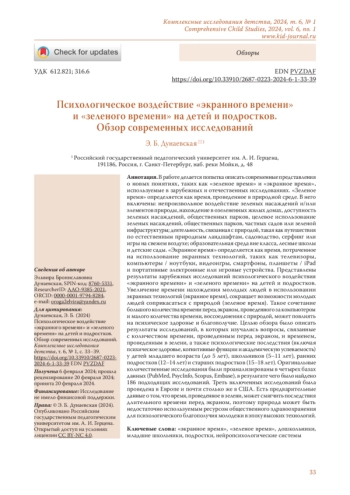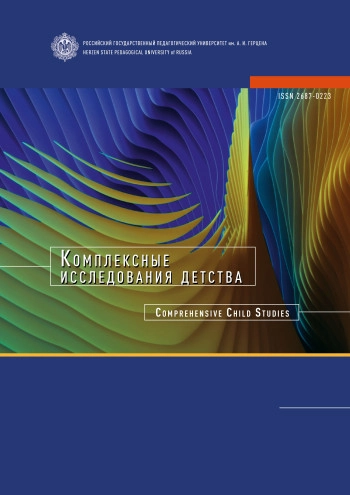1. Aguilar, M. M., Vergara, F. A., Velásquez, E. J. A. et al. (2015) Screen time impairs the relationship between physical fitness and academic attainment in children. Jornal de Pediatria, vol. 91, no. 4, pp. 339-345. (In English). DOI: 10.1016/j.jped.2014.10.004
2. Babic, M. J., Smith, J. J., Morgan, P. J. et al. (2017) Longitudinal associations between changes in screen-time and mental health outcomes in adolescents. Mental Health and Physical Activity, vol. 12, pp. 124-131. (In English). DOI: 10.1016/j.mhpa.2017.04.001
3. Brunetti, V. C., O’Loughlin, E. K., O’Loughlin, J. et al. (2016) Screen and nonscreen sedentary behavior and sleep in adolescents. Sleep Health, vol. 2, no. 4, pp. 335-340. (In English). DOI: 10.1016/j.sleh.2016.09.004
4. Busch, V., Loyen, A., Lodder, M. et al. (2014) The effects of adolescent health-related behavior on academic performance: A systematic review of the longitudinal evidence. Review of Educational Research, vol. 84, no. 2, pp. 245-274. (In English). DOI: 10.3102/0034654313518441
5. Chassiakos, C. Y., Radesky, J. S., Christakis, D. et al. (2016) Council on communications and media. Children and Adolescents and Digital Media. Pediatrics, vol. 138, no. 5, article e20162593. (In English). DOI: 10.1542/peds.2016-2593
6. Chauhan, S. (2017) A meta-analysis of the impact of technology on learning effectiveness of elementary students. Computers & Education, vol. 105, pp. 14-30. (In English). DOI: 10.1016/j.compedu.2016.11.005
7. Corder, K., Atkin, A. J., Bamber, D. J. et al. (2015) Revising on the run or studying on the sofa: Prospective associations between physical activity, sedentary behaviour, and exam results in British adolescents.International Journal of Behavioral Nutrition and Physical Activity, vol. 12, article 106. (In English). DOI: 10.1186/s12966-015-0269-2
8. Corder, K., Sharp, S. J., Atkin, A. J. et al. (2016) Age-related patterns of vigorous-intensity physical activity in youth: The international children’s accelerometry database. Preventive Medicine Reports, vol. 4, pp. 17-22. (In English). DOI: 10.1016/j.pmedr.2016.05.006
9. Dettweiler, U., Becker, C., Auestad, B. H. et al. (2017) Stress in school. Some empirical hints on the circadian cortisol rhythm of children in outdoor and indoor classes.International Journal of Environmental Research and Public Health, vol. 14, no. 5, article 475. (In English). DOI: 10.3390/ijerph14050475
10. Domingues-Montanari, S. (2017) Clinical and psychological effects of excessive screen time on children. Journal of Paediatry and Child Health, vol. 53, no. 4, pp. 333-338. (In English). DOI: 10.1111/jpc.13462
11. Duch, H., Fisher, E. M., Ensari, I. et al. (2013) Association of screen time use and language development in Hispanic toddlers: A cross-sectional and longitudinal study. Clinical Pediatrics, vol. 52, no. 9. pp. 857-865. (In English). DOI: 10.1177/0009922813492881
12. Dzhambov, A., Hartig, T., Markevych, I. et al. (2018) Urban residential greenspace and mental health in youth: Different approaches to testing multiple pathways yield different conclusions. Environmental Research, vol. 160, pp. 47-59. (In English). DOI: 10.1016/j.envres.2017.09.015
13. Feda, D. M., Seelbinder, A., Baek, S. et al. (2015) Neighbourhood parks and reduction in stress among adolescents: Results from Buffalo, New York. Indoor and Built Environment, vol. 24, no. 5, pp. 631-639. (In English). DOI: 10.1177/1420326X14535791
14. Feng, X., Astell-Burt, T. (2017) Residential green space quantity and quality and child well-being: A longitudinal study. American Journal of Preventive Medicine, vol. 53, no. 5, pp. 616-624. (In English). DOI: 10.1016/j.amepre.2017.06.035
15. Firth, J., Torous, J., Stubbs, B. et al. (2019) The “online brain”: How the Internet may be changing our cognition. World Psychiatry, vol. 18, no. 2, pp. 119-129. (In English). DOI: 10.1002/wps.20617
16. Galvan, A. (2010) Adolescent development of the reward system. Frontiers in Human Neuroscience, vol. 4, article 6. (In English). DOI: 10.3389/neuro.09.006.2010
17. García-Hermoso, A., Marina, R. (2017) Relationship of weight status, physical activity and screen time with academic achievement in adolescents. Obesity Research & Clinical Practice, vol. 11, no. 1, pp. 44-50. (In English). DOI: 10.1016/j.orcp.2015.07.006
18. Giedd, J. N. (2012) The digital revolution and adolescent brain evolution. Journal of Adolescent Health, vol. 51, no. 2, pp. 101-105. (In English). DOI: 10.1016/j.jadohealth.2012.06.002
19. Hale, L., Guan, S. (2015) Screen time and sleep among school-aged children and adolescents: A systematic literature review. Sleep Medicine Reviews, vol. 21, pp. 50-58. (In English). DOI: 10.1016/j.smrv.2014.07.007
20. Hartig, T., Mitchell, R., de Vries, S., Frumkin, H. (2014) Nature and health. Annual Review in Public Health, vol. 35, pp. 207-228. (In English). DOI: 10.1146/annurev-publhealth-032013-182443
21. Kaplan, S. (1995) The restorative benefits of nature: Toward an integrative framework. Journal of Environmental Psychology, vol. 15, no. 3, pp. 169-182. (In English). DOI: 10.1016/0272-4944(95)90001-2
22. Kremer, P., Elshaug, C., Leslie, E. et al. (2014) Physical activity, leisure-time screen use and depression among children and young adolescents. Journal of the Science and Medical Sport, vol. 17, no. 2, pp. 183-187. (In English). DOI: 10.1016/j.jsams.2013.03.012
23. Lacy, K. E., Allender, S. E., Kremer, P. J. et al. (2012) Screen time and physical activity behaviours are associated with health-related quality of life in Australian adolescents. Quality of Life Research, vol. 21, no. 6, pp. 1085-1099. (In English). DOI: 10.1007/s11136-011-0014-5 EDN: MKUNSC
24. Lamblin, M., Murawski, C., Whittle, S., Fornito, A. (2017) Social connectedness, mental health and the adolescent brain. Neuroscience & Biobehavioral Reviews, vol. 80, pp. 57-68. (In English). DOI: 10.1016/j.neubiorev.2017.05.010
25. LeBourgeois, M. K., Hale, L., Chang, A.-M. et al. (2017) Digital media and sleep in childhood and adolescence. Pediatrics, vol. 140, suppl. 2, pp. S92-S96. https://doi.org/10.1542%2Fpeds.2016-1758J (In English).
26. Lenhart, A. (2015) Teens, social media & technology overview 2015. Pew Research Center. [Online]. Available at: https://www.pewresearch.org/internet/2015/04/09/teens-social-media-technology-2015/(accessed 05.01.2024). (In English).
27. Li, D., Sullivan, W. C. (2016) Impact of views to school landscapes on recovery from stress and mental fatigue. Landscape and Urban Planning, vol. 148, no. 4, pp. 149-158. (In English). DOI: 10.1016/j.landurbplan.2015.12.015
28. Maras, D., Flament, M. F., Murray, M. et al. (2015) Screen time is associated with depression and anxiety in Canadian youth. Preventive Medicine, vol. 73, pp. 133-138. (In English). DOI: 10.1016/j.ypmed.2015.01.029
29. Mendelsohn, A. L., Brockmeyer, C. A., Dreyer, B. P. et al. (2010) Do verbal interactions with infants during electronic media exposure mitigate adverse impacts on their language development as toddlers? Infant and Child Development, vol. 19, no. 6, pp. 577-593. (In English). DOI: 10.1002/icd.711
30. Mundy, L. K., Canterford, L., Olds, T. et al. (2017) The association between electronic media and emotional and behavioral problems in late childhood. Academic Pediatrics, vol. 17, no. 6, pp. 620-624. (In English). DOI: 10.1016/j.acap.2016.12.014
31. Nathanson, A. I., Beyens, I. (2018) The role of sleep in the relation between young children’s mobile media use and effortful control. British Journal of Developmental Psychology, vol. 36, no. 1, pp. 1-21. (In English). DOI: 10.1111/bjdp.12196
32. Oswald, T. K., Rumbold, A. R., Kedzior, S. G. E., Moore, V. M. (2020) Psychological impacts of “screen time” and “green time” for children and adolescents: A systematic scoping review. PLoS One, vol. 15, no. 9, article e0237725. (In English). DOI: 10.1371/journal.pone.0237725 EDN: IVBDFF
33. Padmanabhan, A., Geier, C. F., Ordaz, S. J. et al. (2011) Developmental changes in brain function underlying the influence of reward processing on inhibitory control. Developmental Cognitive Neuroscience, vol. 1, no. 4, pp. 517-529. (In English). DOI: 10.1016/j.dcn.2011.06.004 EDN: XZNPOA
34. Przybylski, A. K., Weinstein, N. (2017) A large-scale test of the goldilocks hypothesis: Quantifying the relations between digital-screen use and the mental well-being of adolescents. Psychological Science, vol. 28, no. 2, pp. 204-215. (In English). DOI: 10.1177/0956797616678438
35. Sandercock, G. R. H., Ogunleye, A., Voss, C. (2012) Screen time and physical activity in youth: Thief of time or lifestyle choice? Journal of Physical Activity and Health, vol. 9, no. 7, pp. 977-984. (In English). DOI: 10.1123/jpah.9.7.977
36. Suchert, V., Hanewinkel, R., Isensee, B., Group, I. S. (2015) Sedentary behavior, depressed affect, and indicators of mental well-being in adolescence: Does the screen only matter for girls? Journal of Adolescence, vol. 42, no. 1, pp. 50-58. (In English). DOI: 10.1016/j.adolescence.2015.03.014
37. Syväoja, H. J., Kantomaa, M. T., Ahonen, T. et al. (2013) Physical activity, sedentary behavior, and academic performance in Finnish children. Medicine and Science in Sports and Exercise, vol. 45, no. 11, pp. 2098-2104. (In English). DOI: 10.1249/mss.0b013e318296d7b8
38. Tomopoulos, S., Dreyer, B. P., Berkule, S. et al. (2010) Infant media exposure and toddler development. Archive of Pediatrics and Adolescene Medicine, vol. 164, no. 12, pp. 1105-1111. (In English). DOI: 10.1001/archpediatrics.2010.235
39. Tremblay, M. S., LeBlanc, A. G., Kho, M. E. et al. (2011) Systematic review of sedentary behaviour and health indicators in school-aged children and youth.International Journal of Behavioral, Nutrition and Physical Activity, vol. 8, article 98. (In English). DOI: 10.1186/1479-5868-8-98
40. Twenge, J. M., Spitzberg, B. H., Campbell, W. K. (2019) Less in-person social interaction with peers among U.S. adolescents in the 21st century and links to loneliness. Journal of Social and Personal Relationships, vol. 36, no. 6, pp. 1892-1913. (In English). DOI: 10.1177/0265407519836170
41. Uhls, Y. T., Ellison, N. B., Subrahmanyam, K. (2017) Benefits and costs of social media in adolescence. Pediatrics, vol. 140, suppl. 2, pp. S67-S70. (In English). DOI: 10.1542/peds.2016-1758e
42. Ulrich, R. S., Simons, R. F., Losito, B. D. et al. (1991) Stress recovery during exposure to natural and urban environments. Journal of Environmental Psychology, vol. 11, no. 3, pp. 201-230. (In English). DOI: 10.1016/S0272-4944(05)80184-7
43. Wahlstrom, D., Collins, P., White, T., Luciana, M. (2010a) Developmental changes in dopamine neurotransmission in adolescence: Behavioral implications and issues in assessment. Brain and Cognition, vol. 72, no. 1, pp. 146-159 (In English). DOI: 10.1016/j.bandc.2009.10.013
44. Wahlstrom, D., White, T., Luciana, M. (2010b) Neurobehavioral evidence for changes in dopamine system activity during adolescence. Neuroscience & Biobehavioral Reviews, vol. 34, no. 5, pp. 631-648. (In English). DOI: 10.1016/j.neubiorev.2009.12.007
45. Ward, J. S., Duncan, J. S., Jarden, A., Stewart, T. (2016) The impact of children’s exposure to greenspace on physical activity, cognitive development, emotional wellbeing, and ability to appraise risk. Health & Place, vol. 40, pp. 44-50. (In English). DOI: 10.1016/j.healthplace.2016.04.015
46. Wright, K. P. Jr., McHill, A. W., Birks, B. R. et al. (2013) Entrainment of the human circadian clock to the natural light-dark cycle. Current Biology, vol. 23, no. 16, pp. 1554-1558. (In English). DOI: 10.1016/j.cub.2013.06.039







